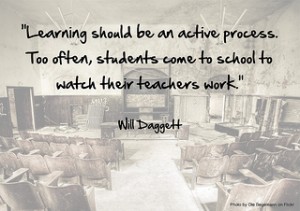Self-directed Learning (SDL) is an approach where students select and investigate topics of their own choosing, often using methods, information sources and/or tools that they have also selected for themselves. The intention behind the approach is that students will be more engaged and motivated when they are able to focus on those topics where they have a personal interest. The final dissertation or project is the most common example of SDL in undergraduate degrees, though the approach can be scaled down for use in other situations, ranging from a single session to across a module.
How it Works
The students are provided with a set of parameters and criteria and use these to frame their learning experience. Students in an SDL activity will often make decisions about what they would like to learn and the method and tools used to get there, for example three students may want to learn about the same aspect of local history, but one may choose to work alone in the library and archives whereas the other two work together and conduct interviews with local people about the topic.
As the students are likely to select a wide variety of different topics and methods, the role of the tutor changes from being the ‘expert’ delivering information and specific guidance to one of supporting the students in their activities and discoveries. This means that tutors must have confidence in the abilities of the students and trust that they can stay motivated and remain focused on their learning.
Possible Technologies to Support the Approach
As the students are typically able to select the tools and methods that they use, the technologies that could be used to support the approach are largely dependent on the students. However, there are some technologies that can be used by the students to record their progress and obtain guidance from tutors and peers. Wikis, Google Sites and Google Docs allow students to create resources, either individually or in groups, and share these with tutors for feedback and guidance. Blogs, either personal or group ones, are an ideal way to record processes and solicit comments and feedback, whereas ePortfolios are a good way for students to collect multiple resources into a coherent whole.
Getting Started
If you are interested in trying out SDL there are a few practical questions that you should answer:- Where in the course/module would this approach work best?
- What constraints on topics and methods should there be?
- How will the students share their work with tutors (and others)?
- Are the students (and other tutors) ready for this?
Having thought about these questions, you should have worked out whether SDL is an approach that makes sense in your context and have some ideas about how to introduce it. If you are still unsure, you could try a small SDL exercise in a single session and see how the students respond.
Further Resources
Case studies from SHU:
The following links are to case studies showing how staff at SHU have used SDL ideas in their teaching:
- Developing learning literacies with digital posters – Diane Rushton
- Encouraging learner autonomy through small, self-selected research projects – Chris Corker & Sarah Holland
- Mobile innovation: Using QR codes to support individual learning projects – John Lee
- Promoting learner autonomy through media production and presentations – Mike Bramhall
Related ‘Teaching Nuggets’:
The following links provide further information on some activities and assessment outputs that can work well with SDL tasks, especially for students who are part-time or not campus-based:
Other resources:
- Teaching Approaches Menu – Sheffield Hallam University

!["2014-01-27 Self-directed learning flow" by Sacha Chua [Click to enlarge]](https://blogs.shu.ac.uk/shutel/files/2014/07/12182837973_2561f58f99_m.jpg)


